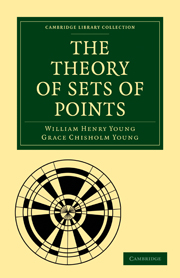Book contents
- Frontmatter
- PREFACE
- Contents
- CHAPTER I RATIONAL AND IRRATIONAL NUMBERS
- CHAPTER II REPRESENTATION OF NUMBERS ON THE STRAIGHT LINE
- CHAPTER III THE DESCRIPTIVE THEORY OF LINEAR SETS OF POINTS
- CHAPTER IV POTENCY, AND THE GENERALISED IDEA OF A CARDINAL NUMBER
- CHAPTER V CONTENT
- CHAPTER VI ORDER
- CHAPTER VII CANTOR'S NUMBERS
- CHAPTER VIII PRELIMINARY NOTIONS OF PLANE SETS
- CHAPTER IX REGIONS AND SETS OF REGIONS
- CHAPTER X CURVES
- CHAPTER XI POTENCY OF PLANE SETS
- CHAPTER XII PLANE CONTENT AND AREA
- CHAPTER XIII LENGTH AND LINEAR CONTENT
- APPENDIX
- BIBLIOGRAPHY
- INDEX OF PROPER NAMES
- GENERAL INDEX
CHAPTER IV - POTENCY, AND THE GENERALISED IDEA OF A CARDINAL NUMBER
Published online by Cambridge University Press: 07 September 2010
- Frontmatter
- PREFACE
- Contents
- CHAPTER I RATIONAL AND IRRATIONAL NUMBERS
- CHAPTER II REPRESENTATION OF NUMBERS ON THE STRAIGHT LINE
- CHAPTER III THE DESCRIPTIVE THEORY OF LINEAR SETS OF POINTS
- CHAPTER IV POTENCY, AND THE GENERALISED IDEA OF A CARDINAL NUMBER
- CHAPTER V CONTENT
- CHAPTER VI ORDER
- CHAPTER VII CANTOR'S NUMBERS
- CHAPTER VIII PRELIMINARY NOTIONS OF PLANE SETS
- CHAPTER IX REGIONS AND SETS OF REGIONS
- CHAPTER X CURVES
- CHAPTER XI POTENCY OF PLANE SETS
- CHAPTER XII PLANE CONTENT AND AREA
- CHAPTER XIII LENGTH AND LINEAR CONTENT
- APPENDIX
- BIBLIOGRAPHY
- INDEX OF PROPER NAMES
- GENERAL INDEX
Summary
The principle of measurement has been analysed into two primary constituents. The first is the determination of a standard object, or unit; the second is the calculation of how many times the unit has to be taken so as to be equivalent to the object to be measured in respect of size. The answer to the question—how many times?—would be given in the form of a positive integer, and would be determined by counting, that is, by setting up a (1, 1)-correspondence between the repeated unit and the several parts of the object under discussion, properly divided and arranged. Sometimes the question could not be answered accurately, and it was necessary to take a new unit. When the old unit could itself be accurately measured integrally by means of the new unit, the idea of ratio in the Euclidean sense and the introduction of fractional symbols, enabled people to do without the new unit. In the same way the generalised idea of ratio and the concept of an irrational number such as we have defined it, made the new unit superfluous, whenever the ratio could be expressed approximately by means of rational numbers forming a sequence.
This idea of measurement we are going to apply to the theory of sets of points, or numbers. We are going to answer, as far as we can, the question,—how large is a given set?—or, put more precisely,—how many points are there in a given set?
- Type
- Chapter
- Information
- The Theory of Sets of Points , pp. 33 - 75Publisher: Cambridge University PressPrint publication year: 2009First published in: 1906

